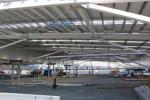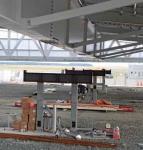From The Ground Up
By Graham Hepburn
Building a new hangar at a working airport comes with its challenges, especially when you aren’t allowed cranes on site. And those challenges magnify when the hangar is 80 metres wide by 60 metres long and 15 metres tall at its highest point.
Air Nelson needed the new hangar at Nelson Airport to have a clear span of 80 metres so it could house five of its Bombardier Q300 aircraft. The hangar also had to have the capacity to accommodate the bigger Bombardier Q400 if Air Nelson upgrades its fleet. The project also included 700m2 of an attached amenities area consisting of two aircraft parts storerooms, a tool room, a workshop, mezzanine floor and a staff amenities and toilet block.
Cranes couldn’t be used on site because of the danger they would pose to air traffic so the solution was to build the roof of the hangar on the ground and jack it up almost 8 metres before building the supporting steel framework beneath it.
Architect Don Gillies, the founding director of Tetrad Design Group, said Air Nelson wanted the new hangar to acknowledge the existing hangar, built in the 1940s, which has a heritage classification on its windows. They also wanted the new hangar to have the same roofing and cladding as the existing hangar and be the same colour so COLORSTEEL® Maxx® Multi-rib in Champagne Half-Spring was used – even on the 12-leaf, 9.5 metre high motorised doors that, when retracted, provide a 55m-wide clear opening. Almost 9km of longrun was required for the roofing and cladding, which is also insulated for the comfort of technical crew working on the planes at night.
Don says that building the roof on the ground saved time and money – and gave a better result. “It probably saved us four weeks in time,” says Don “and the construction crew had better control of the job and a hell of a lot of health and safety issues went away because the work was being done on the ground.” Even if cranes had been allowed on the project, finding big enough equipment locally would have been a problem. A crane would probably have to have been brought in from the North Island just to lift the packets of COLORSTEEL® on to the roof.
Don says constructing the roof on the ground also meant that most of the ceiling mounted services such as gas heaters, lights and fire protection could go in at the same time rather than having to be installed by tradesmen working at great heights. Stephen Hogg, an executive in structural engineering at Aurecon, says because the roof was designed to be jacked up, it was built with three load bearing beams rather than as a portal framed structure.
Stephen says the steel I beams are 60 metres long (made up of 5 12-metre beams bolted together) and are 2.4 metres deep with flanges 600mm wide and steel 40mm thick. One of the beams sits at the apex of the roof with a beam either side about 10 metres from the edge of the 80 metre-wide roof. A system of steel rafters, purlins and fly braces completes the structure.
The 391 tonne roof was hydraulically jacked up on five 14 metre-high pre-cast concrete columns that had ground anchors to keep them straight under stress. The design employed three concrete columns at the rear and two at the front, with a jack on each. Channels in the concrete columns were used to guide the roof up as it was lifted 300mm a time, one column at a time. Once the roof had been jacked 300mm on a particular column it was locked off and the same process began on the next column, with the jacking process done mostly in rotation on the columns unless one part of the roof needed more jacking to keep it on plane.
Stephen says three 100-tonne hydraulic jacks powered by electric motors were used for the rear of the roof, while two 200-tonne jacks helped to raise the front. The rear of the roof was jacked up from the bottom, while the front had the jacks at the top of the two columns raising the big doorhead truss which was effectively sitting in a cradle. “From my point of view, the trickiest bit of it all was getting us as engineers and the steel fabricators aligned so we all knew what we were going to do and that it was safe,” says Stephen.
The project was overseen by Graeme Earl, Mainzeal’s Southern Region construction manager, who says the jacking process put stress on the roof but it was manageable.
“Lifting it one column at a time means you’re warping the roof a little bit but it’s well within the tolerance of the metal roof,” says Graeme.
The process took five days and went smoothly despite the small tolerances they were working with, and Graeme says that was all down to planning.
“We delayed the lift by a week just to make sure we got everything right before we attempted it,” he says.
Over five days, bad weather was always going to be a worry during such a mammoth undertaking, especially when there was no going back.
“Obviously wind was a big issue for us but we were monitoring it throughout,” says Graeme. Stephen says that at one stage the wind did get up to 20-25 knots causing the ends of the roof to flap. This was solved by using truck tie-downs attached to the foundations to hold the roof taut and these were released and retightened as the roof went up. “And the big thing was that once we got the roof up to height we had to get the steel columns in and get that all bolted and braced as quickly as possible,” says Graeme.
With the roof and wall cladding in place, that provided the perfect environment for the next big job: pouring the 160mm-thick posttensioned floor slab.
Air Nelson wanted a flawless polished concrete finish, which meant ready-mix concrete being poured over a continuous 16-hour period, with no construction joints. “The floor had to be spotless and that was totally to do with working on the planes,” says Graeme. “One time their mechanics lost a nut off an engine and they thought it had gone into a crack in the floor but it had gone into the motor and it stuffed the motor. So they needed a floor where if they dropped anything they would be able to find it.”
Because the ground was “puggy” the site had already been excavated and hard-filled before the roof went up to provide a stable base for the slab, which required 760 cubic metres of concrete.
Graeme says the pour had to be planned and carried out with military precision to avert problems such as cracking or the concrete setting too quickly.
“We had everyone on standby as far as the concrete plant went and everyone and their dog on standby as far as concrete truck drivers,” says Graeme. “Four loads of cement had to be delivered to the plant to keep it running but we never had a time when there wasn’t a concrete truck waiting at the pump.”
The floor was coated with Ashford Formula sealer, which gives a shiny but grippy finish.
Graeme says the hangar project was a unique one to be involved with as cranes are normally used when constructing large commercial, civil or industrial buildings.
“It has to be one of the biggest roof lifts done in New Zealand.”
Tetrad Design Group
An architectural practice based in Wellington, Tetrad Design Group was established in 1991 and specialises in a wide range of design including architectural, marine, aviation and industrial furniture design. Projects include educational and commercial buildings, industrial facilities and structures, apartment and housing design. The strength of the practice is based on its ability to plan and analyse client needs and projections – an approach that produces practical, consistent and affordable design. Tetrad manages most of its projects from inception, coordinating consultants and acting as lead managers of the construction process.
Mainzeal
Having recently celebrated 40 years of doing business in New Zealand, construction company Mainzeal can look back on many successful projects such as Vector Arena, North Harbour Stadium, Spring Hill Corrections Facility and the Two Double Seven shopping mall redevelopment. Mainzeal’s achievements are testament to he company’s ability to adapt to a changing work environment. It focuses on core principles such as sustainable design; making sure buildings fit the client’s needs, rather than vice versa; proven cost savings; and certainty of outcome for both the client and stakeholders.





